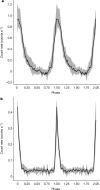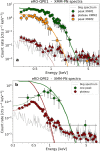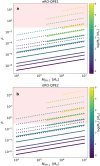X-ray quasi-periodic eruptions from two previously quiescent galaxies
- PMID: 33911275
- PMCID: PMC8081662
- DOI: 10.1038/s41586-021-03394-6
X-ray quasi-periodic eruptions from two previously quiescent galaxies
Abstract
Quasi-periodic eruptions (QPEs) are very-high-amplitude bursts of X-ray radiation recurring every few hours and originating near the central supermassive black holes of galactic nuclei1,2. It is currently unknown what triggers these events, how long they last and how they are connected to the physical properties of the inner accretion flows. Previously, only two such sources were known, found either serendipitously or in archival data1,2, with emission lines in their optical spectra classifying their nuclei as hosting an actively accreting supermassive black hole3,4. Here we report observations of QPEs in two further galaxies, obtained with a blind and systematic search of half of the X-ray sky. The optical spectra of these galaxies show no signature of black hole activity, indicating that a pre-existing accretion flow that is typical of active galactic nuclei is not required to trigger these events. Indeed, the periods, amplitudes and profiles of the QPEs reported here are inconsistent with current models that invoke radiation-pressure-driven instabilities in the accretion disk5-9. Instead, QPEs might be driven by an orbiting compact object. Furthermore, their observed properties require the mass of the secondary object to be much smaller than that of the main body10, and future X-ray observations may constrain possible changes in their period owing to orbital evolution. This model could make QPEs a viable candidate for the electromagnetic counterparts of so-called extreme-mass-ratio inspirals11-13, with considerable implications for multi-messenger astrophysics and cosmology14,15.
Conflict of interest statement
The authors declare no competing interests.
Figures










References
-
- Giustini M, Miniutti G, Saxton R. X-ray quasi-periodic eruptions from the galactic nucleus of RX J1301.9+2747. Astron. Astrophys. 2020;636:L2. doi: 10.1051/0004-6361/202037610. - DOI
-
- Miniutti G, et al. A high Eddington-ratio, true Seyfert 2 galaxy candidate: implications for broad-line region models. Mon. Not. R. Astron. Soc. 2013;433:1764–1777. doi: 10.1093/mnras/stt850. - DOI
-
- Sun L, Shu XW, Wang TRX. J1301.9+2747: a highly variable Seyfert galaxy with extremely soft X-ray emission. Astrophys. J. 2013;768:167. doi: 10.1088/0004-637X/768/2/167. - DOI
-
- Merloni A, Nayakshin S. On the limit-cycle instability in magnetized accretion discs. Mon. Not. R. Astron. Soc. 2006;372:728–734. doi: 10.1111/j.1365-2966.2006.10889.x. - DOI
Publication types
LinkOut - more resources
Full Text Sources
Other Literature Sources

